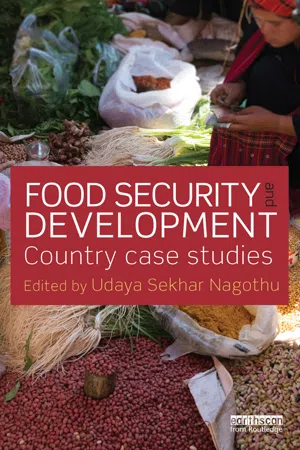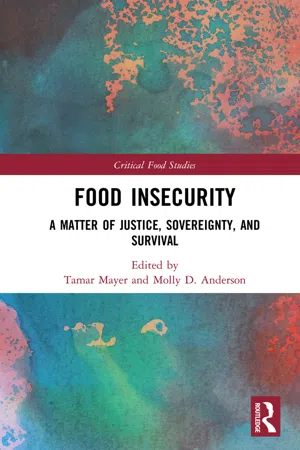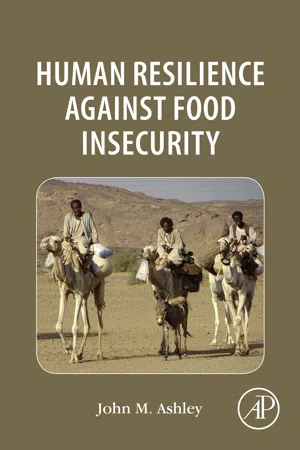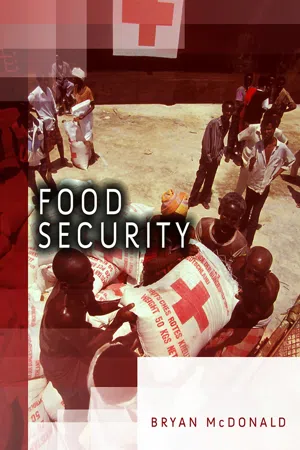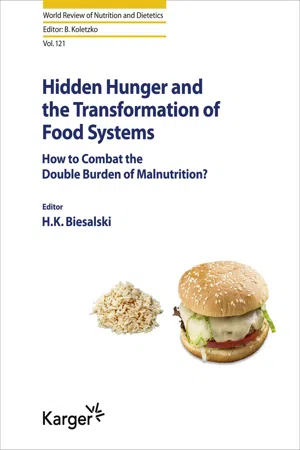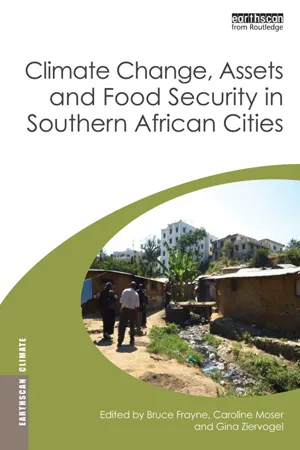Geography
Impacts Of Food Insecurity
Food insecurity refers to the lack of consistent access to enough food for an active, healthy life. Its impacts include malnutrition, poor physical and mental health, and reduced productivity. Food insecurity can also lead to social and economic challenges, such as increased healthcare costs and decreased economic development in affected regions.
Written by Perlego with AI-assistance
8 Key excerpts on "Impacts Of Food Insecurity"
Learn about this page
Index pages curate the most relevant extracts from our library of academic textbooks. They’ve been created using an in-house natural language model (NLM), each adding context and meaning to key research topics.
- eBook - ePub
US Agricultural and Food Policies
Economic Choices and Consequences
- Gerald D. Toland, Jr., William E. Nganje, Raphael Onyeaghala(Authors)
- 2017(Publication Date)
- Routledge(Publisher)
Projections of future global food security conditions are one way to understand the economic factors that influence household nutritional status. We also know that food security is a multi-faceted concept. We should apply a wide-ranging set of analytical techniques to more fully comprehend the causes and consequences of food security (and insecurity).In the final section of this chapter, we consider the question of food insecurity from the broad perspective of household access to foods that are both nutritious and reasonably priced. It seems counterintuitive to discuss the US problems of obesity and diet-related diseases as topics related to household food insecurity. But there are economic factors that logically link these concerns together.A food-secure household does more than consume at a prescribed level of caloric food intake. Food security implies access to a well-rounded diet.39 Consequently, households who lead healthier lifestyles because they consume balanced and nutritional diets fit a description of food security that is more consistent with a holistic perspective.Food-insecure households in the US may lack the food choices necessary for nutritionally healthy diets. Instead, food insecurity can be interpreted to include the household consumption of more readily accessible foods that lack nutritional balance and increase the likelihood of obesity and related dietary problems.40Households in diverse US geographic areas, varying from rural locales to inner-city neighborhoods, may have greater accessibility to convenience stores and fast-food outlets than they do to supermarkets. There are serious concerns about the association between poor diets and the absence of nutritious food options. In a broad sense, this is a food security issue.This question of limited geographic access to nutritional food choices is addressed in the 2008 Farm Bill, where the term “food desert” is formally defined:41A food desert is an area in the United States with limited access to affordable and nutritious food, particularly such an area composed of predominantly lower income neighborhoods and communities. (Title VI, Sec. 7527) - eBook - ePub
Food Security and Development
Country Case Studies
- Udaya Sekhar Nagothu, Udaya Sekhar Nagothu(Authors)
- 2014(Publication Date)
- Routledge(Publisher)
Food Policy for Developing Countries , Pinstrup-Andersen and Watson (2011) use Ericksen’s (2008) notion of food systems as complex, dynamic systems filled with heterogeneous subsystems affected by nonlinear feedbacks as a basis for their analysis. The nonlinearity of the system’s feedback means that a small shock may have one or multiple effects, in contrast to a linear system where effects are always directly proportional to cause. Rather than attempting to isolate and study single causes of food insecurity (e.g. low agricultural output), it is more important to look at forces shaping the food system.The three main challenges the world will face in the coming decades are population growth, economic growth and climate change (FAO, 2009a; UN, 2010; Nelson et al. , 2011). These developments will have a direct impact on food security across the world, in varying degrees (Beddington et al. , 2012; Vermeulen et al. , 2012). Other factors such as technology, food wastage, land degradation, soil and water scarcity, urbanization, shift in trade patterns, migration of people from rural to urban areas, marginalization of women, and policymaking and political instability will affect food systems. With current trajectories, large regional differences in environmental and economic changes will continue to increase divides between the rich and poor. Coastal and mountainous areas and arid regions will be more vulnerable to future impacts from climate change than other regions. The rural poor and women, in particular in the sub-Saharan Africa and the Asia-Pacific regions, will be most affected. A recent report by Cameron et al . (2013) suggests that climate change is an issue of injustice and the likelihood that it might undermine the rights of people, especially the poor, marginalized and vulnerable, and influence future climate negotiations.Environmental changes and food production
Inefficient food systems (production, distribution and wastage) negatively impact the environment, especially land and water resources, and vice versa (IPCC, 2007). Despite the claims that the Green Revolution lifted millions of poor farmers out of poverty, it has also been widely criticized for causing widespread environmental damage to water bodies, forests and biodiversity due to excessive and inappropriate use of fertilizers and pesticides (Hazell and Haddad, 2001; Mosley, 2003). Environmental impacts of agricultural intensification, although not easily observed, tend to have significant long-term effects on food production and food supply. Increased demand for food will most likely lead to further deforestation, biodiversity depletion and soil erosion, water scarcity and intensified use of fertilizers and chemicals, which may in turn increase emission of greenhouse gases and pollution. According to the IAASTD report (2008), social and economic inequities, political uncertainties and changing environmental conditions demand a new approach to sustainable production and consumption at all levels. There are, nevertheless, enormous opportunities to develop food systems that are more environmentally benign, that can be low-cost and efficient in terms of resource use and productivity if the right political will and resources are available (Government Office for Science, 2011). - eBook - ePub
Food Insecurity
A Matter of Justice, Sovereignty, and Survival
- Tamar Mayer, Molly D. Anderson, Tamar Mayer, Molly D. Anderson(Authors)
- 2020(Publication Date)
- Routledge(Publisher)
At heart, every instance of food insecurity stems from inequitable power relations. Amartya Sen (1999:16) famously declared that famine has never occurred in a functioning democracy. We could say with equal surety that food insecurity does not occur in societies in which power is shared equitably; democracy is a manifestation of equity, where the government is responsive to its people. Every case of food insecurity in this volume can be interpreted as resulting from unequal access to resources needed for food production, opportunity, or political voice (and often, from all of these together). Sufficient food is produced for everyone in the world to have adequate calories (Lappé and Collins 2015), at least at the current point in global warming. But how should this food be allocated? Is “the market” adequate to distribute food to places of scarcity, or does it need to be mediated by public policy, perhaps based on recognition of the human right to food and nutrition?UN agencies primarily attributed the decline in reliable access to food from 2014 to 2017 to climate change and political conflicts resulting in warfare (FAO, IFAD, UNICEF, WFP, and WHO 2019). These issues have been compounded by the failure to fully recover from the 2007–08 economic crisis, neoliberal austerity policies, scarcity of essential natural resources and environmental degradation, speculation in agricultural markets, and increasing demand for biofuels by wealthy countries. These contributed to the “food price crisis” of 2008 (McMichael 2009; Wise and Murphy 2013), which was followed by another sharp rise in 2010. Each of these factors alone has had a severe impact on food prices and food security and, because they are intertwined, their impact has been devastating, particularly in countries where governments have not been responsive to immediate needs of their population.Climate change
The effects of climate change on food insecurity should be called out explicitly because this is the most dangerous harbinger, largely caused by greenhouse-gas emissions from relatively wealthy countries yet borne mostly by populations in poor countries who have benefited little from burning fossil fuels. Global warming is already 1°C above the postindustrial average, and, if current emission rates continue, the world is on track to hit 1.5°C above that mark as soon as 2030. The impact of global warming on human and natural systems is already apparent, and some of the services that ocean and land ecosystems provide have already changed for the worse. Even if emissions drop drastically in the near future, continued effects are locked in by the amounts of greenhouse gases that are already in the atmosphere. The effects include severe droughts, floods, tropical cyclones and hurricanes, heat waves sufficient to kill livestock and humans, sea-level rise and saltwater intrusion in low-lying coastal areas, and loss of biodiversity, including fish species on which human populations depend. - eBook - ePub
- John Michael Ashley(Author)
- 2018(Publication Date)
- Academic Press(Publisher)
During a crisis, fragile states may lack the capacity or institutional framework to implement long-term food security solutions, a situation often compounded by poor governance, conflicts, man-made disasters, malaria, measles, HIV/AIDS, Ebola and other diseases. Where states' governments lack the capacity or the will to address the risks and needs faced by the most vulnerable people, international resources continue to play an important role. Section 2.5 of the earlier book discusses differential vulnerability to food and nutrition insecurity, at community and individual levels. The communities most at risk include the rural poor, urban communities in conflict and slum dwellers, while at individual level it is children, women, the handicapped, sick and infirm. The FAO has established that agricultural production needs to increase by 60% between 2005 and 2050 to enable the projected population of 10 billion people by then to be fed. Already, increasing population pressure on land and water is reducing agricultural productivity and environmental integrity. The earlier book points out that climate change will likely intensify that pressure in the developing world, adding to the difficulty of reconciling food needs with production potential. Food production, storage, distribution and use systems are needed that are equitable and sustainable in all dimensions: economic, social and environmental. On the production side, a more resilient food system can in part be brought about through better technical efficiencies of irrigation systems or introduction of more drought- and/or saline-tolerant crop varieties. Climate change will affect all four dimensions of food security: food availability, food accessibility, food utilization and food systems stability. It will have an impact on human health, livelihood assets, food production and distribution channels, as well as changing purchasing power and market flows - George Auma Kararach(Author)
- 2022(Publication Date)
- Routledge(Publisher)
As evidence of the wide consequences of diverse effects of poor access, lower levels of education attainment have been directly linked to the high food insecurity in Tanzania (Knueppel et al., 2009) – highlighting the importance of school feeding programs as public action to close the gap between poor food access and policy rhetoric. Gutu et al. (2012) showed that in Ethiopia, climate variability significantly increases from year to year, drastically affecting food production. Climate change in Africa can reduce crop yields and, in turn, result in the increase of prices of food and consequently force people to change production and consumption patterns (EU, 2009). Schmidhuber and Tubiello (2007) estimate that between 5 and 170 million Africans are at risk of hunger by the year 2080. Hendriks (2005) argued that although South Africa has traditionally been considered to be food-secure, between 58% and 73% of households are food-insecure. Clearly, climate change presents a high risk on food security in SSA. To mitigate these risks, there is, therefore, need for an integrated policy approach to protect arable land against global warming (Masipa, 2017). 5.7 Food sovereignty and agricultural policy Food security in Africa may be understood from a policy and institutional dimension. Azizi (2001) and Schwarzwadder (2012) are a few of the scholars that adopt this approach to closing the gap between the reality of food insecurity and policy rhetoric. It goes without saying that food and nutritional crisis and insecurity may arise because of failure in government policies, programs and institutions, political crisis and instability, among other factors. Focusing on East Africa, Onian’o (2009:4) noted that prolonged political crisis and conflict linked to resource competition have occasioned food/nutritional crises. In Southern Africa, Bird et al. (2003) examined the “political background to policy failure” that resulted in food security crises- eBook - ePub
- Bryan L. McDonald(Author)
- 2013(Publication Date)
- Polity(Publisher)
Each of these trends is having an impact on food security, but considerable interactive effects among these trends also multiply their total impacts. For example, population growth, urbanization, changing consumption patterns, and climate change are all likely to place significant new stresses on the environment. The development of more sustainable and adaptive agricultural systems, in addition to providing strategies to address climate variability and change, could also provide an array of benefits to reduce the environmental impact of agriculture and food production by providing comprehensive frameworks that address problems such as impacts on land, water, and energy use while also ensuring food security, providing livelihoods and helping maintain health and well-being. As the next three chapters review, these trends, combined with the aggregate impacts of globalization, have transformed the character of food security as a global problem. Food security is being recognized as an area of first-order global political concern. Ensuring food security in the twenty-first century requires: addressing the three major categories of malnutrition that affect people; effectively confronting the impacts of global environmental change; and meeting the challenge of ensuring that food supplies and the global food system remain safe from contaminants, toxins, and harmful diseases. - eBook - ePub
Hidden Hunger and the Transformation of Food Systems
How to Combat the Double Burden of Malnutrition?
- H.K. Biesalski(Author)
- 2020(Publication Date)
- S. Karger(Publisher)
1 ]. This means that there is an unequal and inequitable distribution. One-third of food available is lost and wasted from production to consumption, and some crops are destroyed in order to maintain market prices. Availability at the national level does not ensure accessibility at the level of the household; this is more a function of economic affordability. The purpose here is to suggest ways of improving food security in a manner that is equitable and also sustainable.Vulnerable Groups for Food Insecurity
There are food-insecure people in every country. The list of vulnerable people for food insecurity includes: victims of natural disasters; victims of conflict – internally displaced people, refugees, war victims; people living in informal settlements, migrant workers and their families; marginal populations in urban areas – unemployed, homeless, orphans, street children; at-risk social groups – minorities, illiterate, patients, prisoners, addicts; low-income households, one-parent families; dependents – servants, elderly, handicapped, special needs, pregnant and nursing women, and children. This list is not exhaustive as many people are not available for questioning (no telephones) or do not have a fixed abode (such as those living on rubbish dumps, as may be found outside every large city and in their informal settlements [previously called “slums”]). These latter groups are also not usually on the national census and therefore “do not exist” [2 ]. Considering their lack of access to social services and telephone data collection etc., it follows that most information on the numbers of food-insecure people are underestimates.Governance of Food and Health in Developing Sustainable Food Systems
Both food security and health security (together known as human security) are recognized as fundamental human rights [3 ]. There is a vicious cycle whereby the global food system contributes to the increase in non-communicable chronic disease worldwide (especially diabesity) and thus endangers overall productivity as well as the sustainability of health and food systems. The challenge is to make food systems more equitable, more healthy, and more sustainable [4 - Bruce Frayne, Caroline Moser, Gina Ziervogel, Bruce Frayne, Caroline Moser, Gina Ziervogel(Authors)
- 2013(Publication Date)
- Routledge(Publisher)
In addition to rapid urban growth and widespread poverty in Maputo, the city faces a number of significant environmental challenges. Much of the city’s population is housed informally, and services are limited. This makes much of the urban population highly vulnerable to extreme weather events, and directly impacts their assets and livelihoods. Cyclones and floods are commonplace, and affect the city, which is both coastal and largely flat. Flooding is mainly attributed to the city’s location in the coastal zone and at the confluence of five rivers – the Incomati, Umbeluzi, Maputo, Matola and Tembe – all of which empty into Maputo Bay (Indian Ocean). There is also the Infulene River, a small stream only 24 km in length, and this too ends in Maputo Bay. The poorest residents of the city are concentrated in these rivers’ floodplains, and are largely made up of rural to urban migrants who began to migrate during the civil war and have continued to do so since (Raimundo, I. M., 2009). These floodplains are also where much of the city’s urban agriculture takes place, which is periodically destroyed by severe storms and cyclones, further exacerbating the negative impacts of environmental factors on local resident’s livelihoods. Research indicates that the occurrence and intensity of storms are increasing as a result of climate change, as are mean temperatures and net rainfall (Tadross, 2009). In addition to rapid urban growth and widespread poverty in Maputo, the city faces a number of significant environmental challenges (Araújo, 2003, 2005; Muanamoha, 2002).It is within this vexing confluence of rapid urbanization, widespread and rising urban poverty, and increasingly severe weather patterns that this chapter examines the links between migration, food security and climate change in Maputo.MethodologyIn addition to a range of secondary data sources, this chapter is based on two recent studies in Maputo. The first is the African Food Security Urban Network (AFSUN) Urban Food Security Baseline Survey undertaken in Maputo in late 2008.1 AFSUN also undertook the same survey in 10 other cities in Southern Africa, collecting data on 5453 households and 28,771 people (data were collected on all people living in the household). The sample in Maputo was drawn from poor neighbourhoods, with a total size of 397 households. In this chapter, the survey households are classified by food security status (food secure, food insecure).2The second study conducted a series of focus group discussions and 148 in-depth life history interviews in both migrant sending and receiving areas in Mozambique, including Maputo. The focus of this study was on household dynamics and urbanization, with a focus on gender, choice and migration issues (Raimundo, I. M., 2009).Food Insecurity and Poverty in MaputoThe AFSUN survey (Frayne et al., 2010) shows that 85 per cent of poor urban households in the city are chronically food insecure. The Lived Poverty Index (LPI) (Frayne et al., 2010) is a reliable, self-reported, multidimensional measure of deprivation (‘going without’). When the food security status of the sample is cross-tabulated with the LPI, it is clear that food insecurity is a reasonable proxy measure for poverty (Figure 5.1

